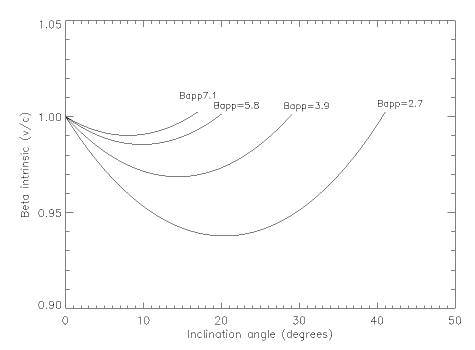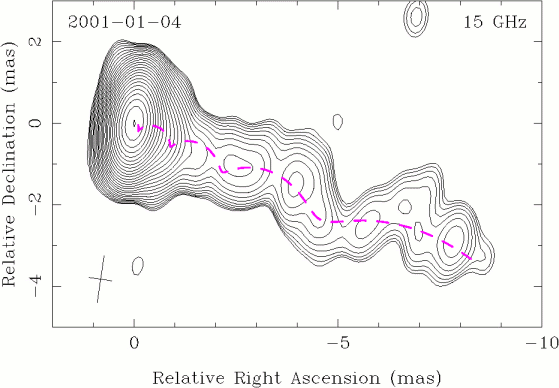
The observed emission ridge was derived from the 15 GHz map of January 4, 2001, by the following method (reference ??): Slices through the image are taken along circular arcs centered at the core position, smoothed by ???, and the maximum flux density along each arc was the location of the emission ridge at that radius.
To estimate the range of model parameters to be searched, we used the measured apparent speeds of components E2, F1, and G, derived by K04, of v/c = 3.9, 5.8, and 7.1. The intrinsic speed, Beta (=v/c) is related to the inclination angle to the line of sight, i, and the apparent speed, Beta_app, as follows:
Beta = Beta_app/[sin(i) + Beta_app * cos(i)]
The curves of Beta versus i are plotted in Figure 8?? for the three values of Beta_app. Also plotted is the curve for Beta_app = 3.9-1.2 = 2.7, subtracting the 1-sigma estimated error. The largest range in Beta and i are allowed by the lowest apparent speed. Thus the allowed range of inclinations is about 0 to 40 degrees, and the the intrinsic Beta is about 0.93 to 1.0.

We have performed a large number (10**6) of simulations covering this
allowed range of parameter space.
The parameters were optimized by chi-squared minimization of the position
differences of the jet ridge data and closest model position.
The best fit model conserved angular momentum, linear momentum,
and jet opening angle.
A common feature of these models is that spacing of helical knots
is shorter close to the AGN core, then increases with distance
from the core until reaching the "linear" region of the jet,
commonly seen for large angular size double lobed radio sources.
The model of PKS 1413+135 shares this feature, although the ridge-line
data appear straighter than the model.
[or does the model appear straighter than the ridge-line data??]
Figure 8B shows the best-fitting model superimposed on the
15 GHz map of the January 4, 2001 data.

Model Fit Results
The optimum model parameters are as follows:
| Inclination to the line of sight | 34.5 ° |
| Jet opening half angle | 1.2 ° |
| Jet launch speed | v/c = 0.7 |
| Phase angle rotation rate | -220.6 ° /mas |
| Size of jet launch region | 0.13 mas |
| Jet orientation on the sky | 23.8 ° |
The rather slow launch rate (v/c = 0.7) and large inclination angle (34.5°) would seem to be inconsistent with the apparent speeds of the faster components. Are components F and G speeding up some time after being launched?